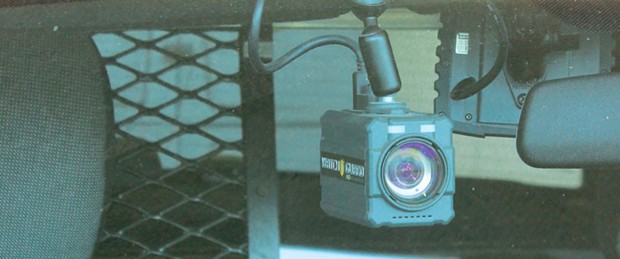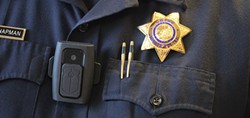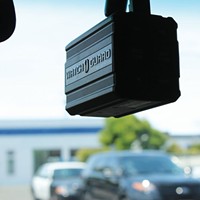News Blog

- The dash camera in a Eureka Police Department patrol car.
Can police videos recorded on body-worn and patrol car dash cameras by considered confidential police officer personnel records and hidden from public view?
That’s the question three justices with the California First Appellate District spent about a half an hour wrestling with in a San Francisco courtroom Thursday. It was clear from their questions that the justices felt deeming the video footage as personnel records would represent an enlargement of the protections currently applied under the law, an enlargement that could have a host of consequences. The arguments touched on everything from California’s open records laws to the very purpose of recording police interactions.
The appellate case is rooted in the Dec. 6, 2012 arrest of a 14-year-old suspect in Eureka. One of the involved officers — former Eureka police Sgt. Adam Laird — was accused of using excessive force during the arrest, leading to an internal affairs investigations and, ultimately, a criminal accusation that he committed assault under the color of authority and falsified a police report to cover it up. In court documents, Laird countered that he acted appropriately in the face of a violent, noncompliant suspect and that he was being targeted and singled out for prosecution because of his liberal political beliefs and his staunch support of a controversial former EPD chief. The primary piece of evidence in the case was video pulled from the dash camera of a responding EPD patrol car, which captured the entirety of the arrest.
The Humboldt County District Attorney’s Office dismissed the case against Laird before the case went to trial and Laird ultimately retired from EPD on July 31, 2014 as a part of the settlement of a claim he brought against the city regarding its handling of his case. He's now working locally as a private defense investigator. (For more background on the case, see past Journal coverage here.)
In the aftermath of the criminal case, the Journal petitioned the Humboldt County Superior Court to release the video and, on May 21, 2015, Judge Christopher Wilson ordered the video released. The city almost immediately appealed Wilson's ruling, arguing he'd erred by not giving the video the same legal protections that are afforded to confidential police officer personnel records. Those legal protections — known as the Pitchess statutes — are outlined in California Penal Code 832.7 and Evidence Code Sections 1043 and 1046, and prescribe a strict procedure for accessing officers’ personnel information, which is defined to include records of complaints and disciplinary action, as well as personal information.

- Eureka recently deployed body worn cameras for all its officers.
After both sides filed briefs arguing their case, the appellate court scheduled oral arguments for June 23 and offered some direction, essentially cutting to the heart of the matter and asking both sides to put technicalities on the back burner and primarily address whether police videos can be considered confidential personnel records under the law. Specifically, the court wanted to know, are these videos records that relate to a police officer’s advancement, appraisal or discipline, and are they records generated by a complaint or the investigation of a complaint pertaining to the manner in which an officer performed his or her duties?
If you haven’t sat in on them before, oral arguments before the court of appeals are an interesting affair with some similarities to arguments before the Supreme Court. Each side is allotted 15 minutes to make its case. Appellants— the city of Eureka, in this case — go first, but can choose to save a portion of their time to offer a closing rebuttal. The catch is that three justices hearing the appeal aren’t required to sit back passively and listen to an attorney’s prepared remarks. Rather, they are free to interject at any time, asking questions and guiding the argument, which can result in their utterly hijacking an attorney’s prepared remarks. (As an example, while we waited for our case to be called, we watched Presiding Justice Barbara Jones spend almost five minutes of an appellant’s argument excoriating the attorney for failing to follow proper filing procedure.)
When our case was called, attorneys entered the center of the oval courtroom and took their seats at council table in front of the justices — Jones, Mark Simons and Henry Needham Jr. — who sat perched atop a wood-paneled bench overlooking the proceeding. The room was bright, with skylights atop the vaulted dome ceiling. As the appellant, Day-Wilson was first to the podium.
She began by addressing one of the core questions the court had posed. However, Day-Wilson got only a couple of minutes into her discussion of Pitchess and a precedent-setting case out of Long Beach when Simons interrupted her.
“Are you aware of any case where a police report has been treated as a confidential personnel record?” the justice asked. Day-Wilson responded that she had not. “What we have here strikes me as, in many ways, quite comparable to a police report,” Simons continued. “It’s not a complaint and, more fundamentally, it’s not a report generated by a police investigation. It exists independently of an investigation. It seems to me quite a significant enlargement of the definition of personnel records. … Police videos are not generated to evaluate police misconduct.”
Needham chimed in: “It’s like contemporaneous evidence. How do you draw the line between evidence that’s out there contemporaneously versus personnel records?,” he asked before asking what if the video had been taken by a citizen with a cell phone. “Does that become a confidential personnel record subject to Pitchess?”
That would be something different, Day-Wilson responded, because it wouldn’t be recorded by the police department. Day-Wilson conceded this is a complicated issue, noting that dashboard and body-worn cameras are becoming more and more prevalent. Then she threw a bit of a curve ball. “The reason for these, at least in our neck of the woods, is that we have so many complaints or allegations of misconduct,” Day-Wilson said, arguing that the reason EPD has these cameras is to evaluate the conduct of its officers, the implication being that EPD officers are under investigation constantly because of the recording devices.
Again, one of the judges interrupted. “You would have us apply this to anything that might record what happened as primary evidence?” Jones asked. Day-Wilson said she wasn’t asking for a blanket ruling, but insisted that, at least in Eureka, these police videos are “records generated as a part of a disciplinary action or appraisal. That’s their primary purpose is to look at officer conduct.” (It's perhaps worth noting that when the purchase of body cameras came before the Eureka City Council, staff represented the technology primarily as an evidence collection tool.)
Simons didn’t sound convinced by Day-Wilson's argument. “I would guess that a significant portion of the intent is to affect the conduct of officers,” he said. “If you know you’re being recorded, that will effect how you do things.”
What about the recording of interrogations, Simons asked. Those exist partly so prosecutors can rebut any allegations that a suspect was beaten or coerced or treated unfairly. Would those, too, be generated to evaluate police misconduct, generated “just in case there’s an investigation?” he asked. “It might be right, but it’s just a big step beyond where we are now.”
Day-Wilson said employers and cities constantly document things in anticipation of disciplinary actions, implying that these videos are no different. “Then why not the police report?” Simons asked, adding it “would be an interesting piece of information” to pass on to defense attorneys, that they would have to go through the cumbersome Pitchess process just to get their clients’ police reports.
With that, Day-Wilson’s time was pretty much up and Paul Nicholas Boylan, the attorney representing the Journal, stepped to the podium.
Boylan said case law is quite clear that incident reports are not personnel records, and noted that video is not specifically enumerated in any of the state laws detailing what constitutes personnel records. And all those state laws, Boylan continued, are designed to create an expectation of privacy.
“The focus is privacy but the tape we’re talking about is in the open, in the world, where there can be no expectation of privacy,” Boylan said.
Further, Boylan argued that California state law is clear that when there’s ambiguity on the topic of whether a record is open to the public the court must err on the side of access. The overwhelming presumption, Boylan said, is that government records in California are public unless the law specifically states otherwise. In the case of Pitchess, the law states that records generated for the appraisal or discipline of an officer are confidential personnel records, but that doesn’t apply here, he said.
“There’s no evidence this was ever created as a part of the officers’ personnel file,” Boylan said. “It’s very clear this is not a Pitchess document. To hold otherwise would create an immediate reduction to the public’s right to access information.”
Given one minute’s time to rebut Boylan’s argument, Day-Wilson took the podium and stressed that she’s not looking for a blanket ruling that drastically alters state law. She said she just wants the Pitchess procedure followed in this case.
“That’s the problem,” interrupted Jones. “You are assuming this is [subject to] Pitchess and we need to get over that.”
With that, Jones said that the matter is considered submitted. The court now has 90 days to issue a ruling.
You can read both the city and the Journal’s legal briefings in the case by clicking the PDFs below. And, for more information about the case and the issue, see past Journal coverage here and this week's cover story here.
City_s_Opening_Brief.pdf
Journal_s_Response_Brief.pdf
City_s_Reply_Brief.pdf
Oral argument direction from the court
Editor’s note: In the interest of full disclosure, it should be noted that this reporter personally filed the petition seeking disclosure of the dash cam video in this case and authored the lower court briefings on behalf of the Journal.

Comments
Showing 1-1 of 1